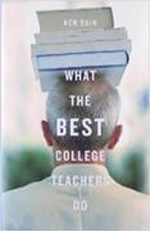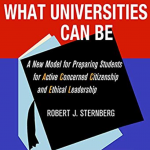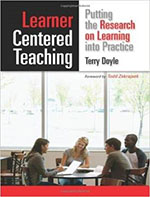A Promising Syllabus – and a Syllabus Clinic Today
Happy New Year! There’s a fresh semester ahead of us. If one of your resolutions is to build an even more galvanizing learning experience for your students, your syllabus—the learning guide for your course—deserves a fresh take, too. A “promising syllabus ” (like the one here) invites students to explore new realms of learning. It describes what they can expect to gain from the course and the activities that will help them fulfill this promise, and “begins a conversation about how the teacher and the student would best come to understand the nature and progress of the student’s learning” (Bain, 2004).
To identify the promise of your course, you may need to reexamine your goals for your students’ learning. What do you really want your students to know or to be able to do when they successfully complete your course—and what will they value? What kind of academic superpowers will the course endow them with? What big ideas will they explore? How will students be transformed by the semester they spend with you?
The tone of your syllabus (especially in the course description and learning goals, but also in the policies) will set the tone for the class, and can either motivate or discourage students. Learner-centered syllabi make the learning goals understandable to students entering the class (rather than to an accrediting agency) and keep the language warm. A syllabus full of prohibitions can dampen the learning environment, conveying low expectations; focusing on opportunities, instead, can foster intrinsic motivation.
In a well-designed course, the activities and assessments help students learn, and help them gauge their progress toward the goals. There should be clear alignment among the goals, the ways you attempt to measure students’ learning, and the practice and feedback they get along the way.
If you’re not sure whether these three components are aligned, or you want to devise new ways of evaluating student learning, consider what sort of evidence students could provide to convince you that they have mastered the goals to the standard you’d like to see. This might involve quizzes, exams, papers, and projects, but may also require more creative,authentic means of measuring learning. Fink (2003) points out that “when we become clear about what constitutes successful student performance, it is much easier to develop effective teaching/learning activities.”
And when you’re thinking about how you’ll use your class time, Doyle’s (2011) mantra is a good reminder: “The one who does the work does the learning.” The more students do, the more they’ll learn, yet “many faculty members do too much of the work for…students, which results in diminished student learning.”
Your grading scheme, and the way you convey it, are also critical. The grading distribution is the “budget” for the course, and conveys the class’s values: it directs students how to spend their time. For example, putting all the weight on three exams tells students that they can think about the class on the three evenings before exams; many will ignore it the rest of the semester. Students will benefit if you reward them for spending their time on those course activities that produce the most learning—whether it’s reading and annotating the textbook, writing, solving problems, discussing in groups, doing projects, etc. If you want students to work on and think about your class every day, you can reallocate points to multiple smaller and scaffolded assignments, including work done in class, so that students are practicing frequently and consistently.
Syllabus Clinic This Afternoon
If you’d like feedback on your syllabus, CAT is hosting a Syllabus Clinic, from noon to 4:00. Drop by our office in 432 Diffenbaugh any time this afternoon, and we can help you determine what your syllabus says about you and your course; fine tune your learning objectives, grading scheme, or assignments; or review any other part of your course design. We look forward to working with you!
Spring Faculty Reading Groups
There are still a few spaces left in some of our faculty reading groups. For an opportunity to connect with colleagues from across the university, delve into the research on learning, and share practical strategies for making your classes even more effective, RSVP here and we’ll send you your complimentary copy of the book. Each group will involve a series of three meetings, so please check your calendar to make sure you can attend. We look forward to working with you!
What the Best College Teachers Do
 Tuesdays, 1/21, 1/28, and 2/3
Tuesdays, 1/21, 1/28, and 2/3
2:00-4:00 in Strozier 027 B
Ken Bain wanted to know how some faculty manage to “make a sustained, substantial, and positive influence on how their students think, act, and feel.” How do some faculty consistently provoke deep learning, while the rest of us merely have good intentions? Bain conducted a fifteen-year study of a hundred extraordinarily effective teachers, to see how they help their students learn. The book traces how these exceptional teachers approach their subjects, their students, and the process of learning.
What Universities Can Be: A New Model for Preparing Students for Active Concerned Citizenship and Ethical Leadership
 Wednesdays 2/12, 2/19, 2/26
Wednesdays 2/12, 2/19, 2/26
2:00-4:00 in 432 Diffenbaugh
Robert Sternberg thinks that universities can do a better job teaching things like wisdom, compassion, creativity, and practical thinking. If we’re preparing students to be leaders for the future, they’ll need all of these skills, and opportunities to practice making ethical decisions. This group will discuss strategies for realizing Sternberg’s ideas in our own classrooms.
Learner Centered Teaching
 Tuesdays, 2/18, 2/25, and 3/3
Tuesdays, 2/18, 2/25, and 3/3
2:00-4:00 in Strozier 027 B
Recent decades have brought a wealth of research on learning and cognition; these developments are gradually making their way into work on best practices for the college classroom. Doyle’s Learner-Centered Teaching: Putting the Research on Learning into Practice is a practical guide to strategies for making effective use of the research. When we adjust our classroom focus from teaching to learning, we make our own work more gratifying, and we can enhance our students’ learning experience as well as their mastery of material. The group will generate specific strategies and activities for enriching our own classrooms.



